
Publications IT As A Driver Of M&A Success
- Publications
IT As A Driver Of M&A Success
- Michael Tierney

SHARE:
Introduction
Businesses today are under more pressure than ever to deliver value to stakeholders, particularly when undertaking bold initiatives such as mergers, acquisitions or asset disposals. This is true not only for corporate acquirers but also for private equity (PE) firms, whose strategy is leaning toward add‐on acquisitions as a means of growing their portfolio companies.
Under the current economic conditions and the rising cost of debt, management teams will require additional effort in restructuring or streamlining operations of acquired businesses to deliver success in the absence of financial engineering.
Information Technology (IT) is fast becoming a key lever which management can use to deliver operational benefits — whether in reducing operational costs, entering emerging markets or scaling their business across multiple geographic regions. With advances in technology and its impact on today’s business models, companies are increasingly pushing the boundaries to remain competitive. IT is one key area to do this — businesses need to view IT as an enabler rather than a cost center.
About this report: All of the strategic initiatives behind a transaction rely on IT. Businesses can no longer ignore IT or view it as a back-office function if they want to achieve maximum value. We have surveyed 220 senior corporate and private equity executives across Europe about the role of IT in the transaction process. Our aim was to uncover the common factors that help to drive deal success.
Key facts
47% say in retrospect that more detailed IT due diligence could have prevented value erosion.
38% of corporate and 22% of PE respondents say they put a significant emphasis on IT as part of their approach to transactions.
20% of respondents recognized IT as one of the most challenging areas to deal with post- transaction despite the significant potential for lost value.
Executive summary
In our interviews with C-suite executives and PE practitioners, we found that IT can be a leading vehicle for growth and value creation if leveraged effectively in transactions. However, despite the considerable upside, executives too often place inadequate focus on IT leading to value erosion or even deal failure. Our survey highlights the opportunities in leveraging IT to drive success in mergers and acquisitions (M&A). We also reveal the challenges and risks that IT can present in the transaction process, which is evidenced by in-depth feedback from the respondents.
IT can enable M&A success but doesn’t feature prominently in respondents’ approach to deals
IT underpins all business functions from human resources (HR) to operations and finance. However, only 38% of corporate and 22% of PE respondents say they put a significant emphasis on IT as part of their approach to transactions. The dependency on IT can present a platform for business opportunity through innovation, or can present risks such as higher costs, lost synergies and unmet deal objectives. At the same time, globalization is adding a new layer of complexity to business, and IT is helping to navigate these challenges. Our interviews revealed that IT often proves a costlier and more time-consuming element of transactions than was originally anticipated.
IT needs to have a seat at the table to deliver real value
One of the most common issues for transactions is not involving IT early enough in the process. Our survey found that only 50% of respondents said they typically involve IT in the transaction process compared to almost 80% for finance. Many also reported inaccurate cost estimates and timelines as a result of not bringing IT to the table early enough. “You need to build the appropriate IT costs into your investment case to avoid major cost overruns,” says Tony Qui, Partner at Ernst & Young LLP.
Understand the strategic value of IT to focus efforts and maximize returns
One of the underlying themes that came out of the qualitative feedback was connecting IT to the strategic drivers behind a transaction. Consolidating product ranges, increasing market share, entering new markets or gaining new customers all rely on a reorganization of the business to some degree. This is all underpinned by IT. Understanding these strategic drivers, set at the C-suite level, will help focus the IT transaction efforts. The alternative is missing the depth or breadth of the IT business needs and negatively impacting the overall strategic objectives.
Plan for day one with a view to day one‐hundred
Including IT in the due diligence stage can help a company to move from integration to innovation. Moreover, a lack of IT due diligence in the pre-deal stage is linked to value erosion — 47% of respondents say in retrospect that more detailed IT due diligence could have prevented value erosion. Respondents consistently pointed to day one business continuity and data migration issues as major challenges. Many respondents also reported that it is necessary to develop a longer-term view of which IT systems needed to be upgraded and which needed to be replaced entirely. All of these factors are important to consider as the cost associated with these changes can directly impact the value of the deal and the planned synergies.
Honestly assess the skills needed to deliver the deal
While involving IT in all phases of the M&A process, the skill set required to make IT an integral part of business strategy is not necessarily present in companies’ internal IT teams. Approximately half of survey respondents (48%) engaged third-party advisors to aid pre-deal IT due diligence and more than half (55%) enlisted third-party help for the post-transaction phase. Further interviews reveal that the combination of transaction experience coupled with a depth of IT knowledge can lead to a higher rate of deal success. It comes down to the detail — such as engaging with all relevant workstreams and getting accurate costings.
How businesses are achieving M&A success through IT
- Embed IT into your approach to transactions.
- Give IT a seat at the table from the start of the deal.
- Establish two-way communications with senior management on the strategic value of IT.
- Plan for day one with a view to day one-hundred.
- Critically assess the skill set needed to deliver the deal.
Pre-deal rigor, post-deal success
Preparation, preparation, preparation
For many respondents, value erosion and unrealized synergies stem from the fact that IT is not given adequate attention or rigor in the pre-deal stages of a transaction. Yet only half of the respondents conducted separate pre-deal IT due diligence for their latest transaction, and only 21% of corporate and 11% of PE respondents, feature IT-related considerations in transaction negotiations.
Whilst IT consistently emerged as a significant challenge to achieving transaction goals, its importance to delivering deal success is often learned too late — 47% of respondents say in retrospect that more detailed IT due diligence could have prevented deal erosion.
The corporate development officer (CDO) of a global chemicals group says: “In our last deal, we went in with basic assumptions about the target’s IT systems, but these assumptions didn’t take into account the difficulties of doing a cross-border acquisition and integration.”
All of these respondents were particularly vocal when it came to identifying past pitfalls. One CIO of a Netherlands-based telecom business explains: “We think of IT-related problems in the context of operational synergies, which are always difficult to capture.
In our last acquisition, the business processes and operations were largely the same for the merging parties, but to get them in a common frame, on the same IT systems, was not easy.”
Another respondent, an operating partner at a Nordic PE firm, says his team has learned the hard way that IT-related missteps can throw off cost estimates: “We knew before the deal that we would need to invest in new IT systems, but later found that the cost was much higher than anticipated.”
Companies involved in M&A transactions need to get to grips with the target’s IT set up as early as possible, in order to assess the value of existing systems and plan where savings can be made after the merger is completed. When asked about the accuracy of costs and time for IT in transactions, 51% of respondents said their time estimates were either too conservative or too generous. This figure was similar for accuracy of cost estimates — 49%. These inaccurate figures often related to the value of targets and the overall costs of completing the deal. The CFO of an Italian chemicals company recognizes the importance of IT in integration planning, saying, “IT is one of the most important factors in medium- and long-term plans, even though these plans are built on a financial basis.”
In the current environment, corporate buyers are held fast to their deal rationale — the synergies they lay out in public announcements, and the timelines they put forth to shareholders and PE firms — must derive value from portfolio companies without the use of financial engineering, meaning value creation is top of the agenda.
It is even more important during pre-merger negotiations, where the costs of upgrading a system cannot be calculated as part of the purchase price unless the buyer has a clear understanding of what is required.
“ In our last deal we went in with basic assumptions about the target’s IT systems, but these assumptions didn’t take into account the difficulties of doing a cross- border acquisition and integration.” – CDO, global chemicals group

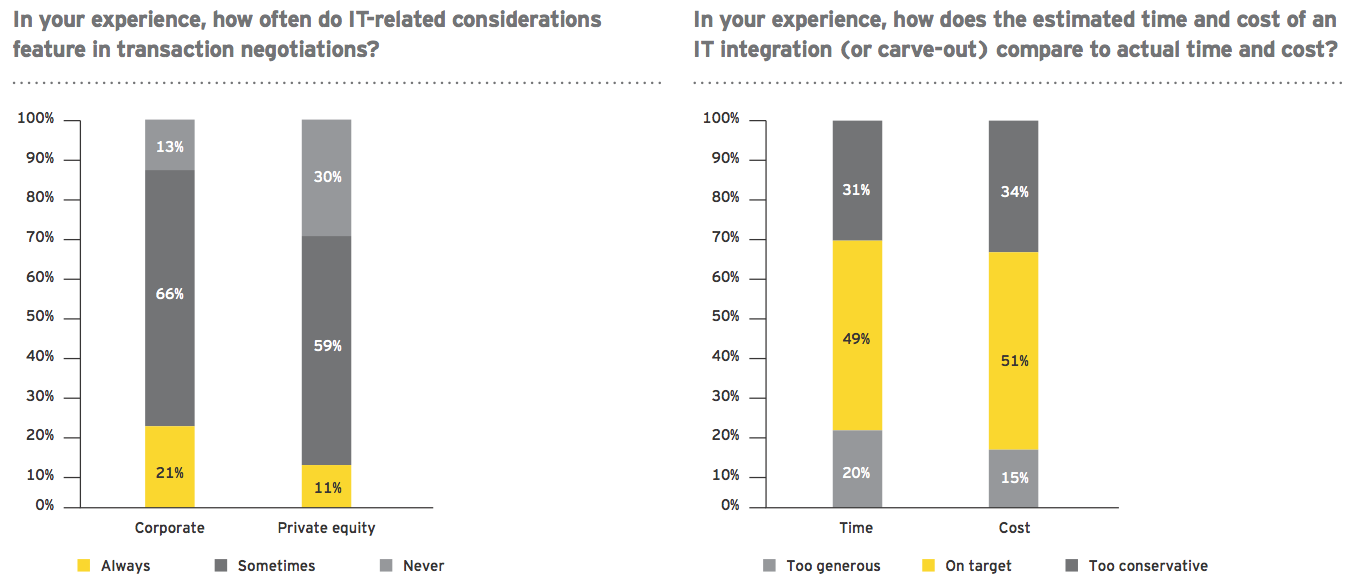
IT: the lynchpin of success
IT underpins all business functions
Our survey found that only 38% of corporates and 22% of PE placed a significant focus on IT as part of their approach to transactions. This could leave executives negotiating in the dark over the potential costs and synergies for the critical assets involved in M&A.
When we looked at the major business functions in more detail, respondents placed greater scrutiny on the finance, operations and sales and marketing functions than IT during the due diligence process. IT not only drives synergies across these back- and front-office functions, but can be a driver of innovation in transactions.
IT plays a crucial role in any business as it links together and underpins all business functions and supports day-to-day operations. Yet companies are underestimating the significant potential for IT to affect the realization of synergies or deal success.
“IT is changing how companies carry out their business, how they deliver goods and how they provide services,” says Tony Qui, Partner and leader for IT transaction services at Ernst & Young LLP. “The biggest issues we see relate to overall information management. This is where companies will see the highest impact on users.” This clearly crosses multiple business functions as it affects managements’ ability to do financial statements, bill customers across different regions, oversee branding guidelines or manage websites. “Even something as simple as email presents questions — do you continue to use the target company’s email address? Can you access the same address book? These are all real-life examples of where things can go wrong.”
When expanding into emerging markets such as Russia and China, for example, IT can also help enable success as it gives you the ability to monitor and to support regulatory compliance in these situations.
IT’s importance goes beyond back-office functions to the source of revenue generation itself. A company’s sales and marketing capabilities — which can be the strategic driver of a deal — are regularly targeted for achieving synergies early in an integration process. While standardizing or integrating information systems may not be achievable straight away, all the information related to these clients needs to be accessible to the sales and customer relationship management (CRM) staff of the combined company from day one.
When asked which functions receive the most attention during due diligence, 79% respondents point to the finance department. A company’s IT and finance functions are largely inseparable: for example, if the accessibility or availability of financial data is poor, it may be indicative of inefficient IT systems — this means the management information needed to run the business is being affected. On top of this, finance teams are heavily reliant upon information systems to invoice customers, pay suppliers, monitor and accurately project their company’s future cash flow.
“IT is changing how companies carry out their business, how they deliver goods and how they provide services.” – Tony Qui, Partner and leader for IT transaction services at Ernst & Young LLP
Business operations and supply chains are closely inspected during due diligence by over half of our respondents. These functions are equally dependent on IT. Information systems can prove critical for business operations at every stage of supply-chain management from raw material procurement to the distribution of finished products. IT can improve inventory management and quality assurance and link production planning to sales and distribution. Management information systems can enhance logistical operations, helping to optimize cost and time efficiencies through improved warehousing, depot routing and the scheduling of deliveries.
On a wider level, enterprise resource planning (ERP) software binds almost all business functions — from data management to payroll and project management — and can only work when given access to all available data.
The human factors — merging company cultures, retaining talented staff and motivating new employees — are notoriously difficult to get right. As such, IT is crucial in ensuring that human resources (HR) is able to communicate progress of the integration effectively to employees, train workers in new areas where needed and manage the most basic functions including payroll and employee benefit systems.
“We think of IT related problems in the context of operational synergies, which are always difficult to capture. In our last acquisition, the business processes and operations were largely the same for the merging parties, but to get them in a common frame, on the same IT systems, was not easy.” – CIO, Dutch telecommunications provider

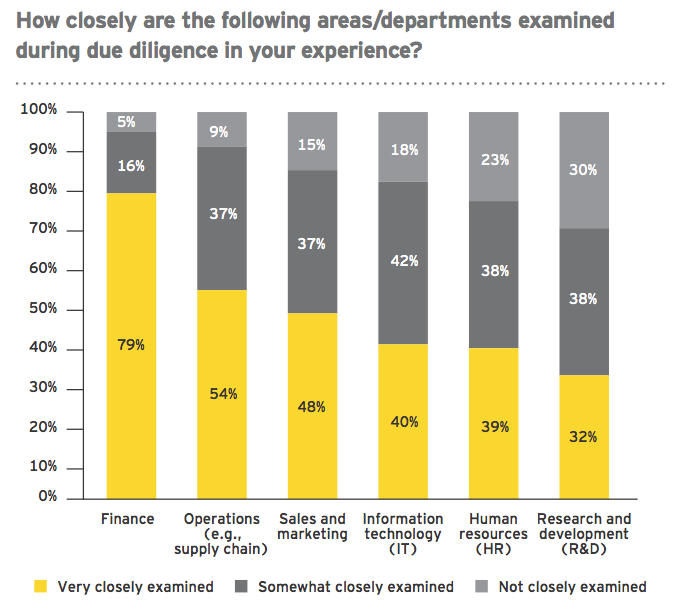
To blend or to build
Decide your approach upfront to avoid costs and capture synergies
During pre-deal planning, management needs to assess whether to build a new IT platform for the combined entity from scratch, or to integrate the systems of the target and the acquirer.
Such decisions must not be added in as a postscript, as they are fundamental in making the deal work cost-effectively and in achieving projected synergies. This was the case for more than a quarter of respondents (26%) who say IT issues often block post-transaction objectives.
One survey participant, the CIO of a global retail business whose acquisition activity has picked up pace in the past three years, echoes this view: “We have a very diverse portfolio of brands and we are adding to it. Data uniformity and systems similarity are often the most difficult post-deal objectives to achieve. These are the things that need to be considered even when identifying targets.”
Speaking a common language
Companies can only integrate systems when there is a clear understanding among all involved of what existing platforms are doing, how they are designed, and their compatibility. Selecting and using common applications, project management tools, processes and templates can give a company a head start. Standardization should mean it is easier to integrate any acquired company’s data and systems more quickly.
Acquisitive companies could take a leaf out of US technology multinational Oracle’s book over how to build a vehicle for change. Between 1999 and 2004, the company consolidated more than 70 individual systems in one ERP system, saving the company US$1b a year, but also creating a platform that supported an ambitious acquisition agenda of more than 50 deals from 2005 to 2009. Oracle is now able to integrate new acquisitions within six months — illustrating having the right blend or build solution up-front is crucial.
New platforms
Building new platforms can play a key role in any integration, especially where two companies have been using drastically different systems prior to the takeover or merger.
“This is not just the case for mega mergers, but also for the smaller transactions — the segments of acquired businesses that need to be integrated with your platforms,” says Christopher Schmitz, Partner at Ernst & Young GmbH. “For example, a major European bank integrated the corporate clients’ business from a large competitor. It was unable to integrate the acquired business onto their existing platform. As an alternative, they rolled out a new platform which will serve as a blueprint for rolling out client business in all their international hubs.”
While a cautious approach is appropriate in some circumstances, other companies are already looking to emerging platforms, such as the cloud or virtualized data centers that help shift weight to shared bases.
Data-heavy firms are already making this switch without the stimulus of a transaction environment, and for companies going through change, this emerging technology is worth serious consideration. These platforms can play a central role in smooth integration processes, making systems easier to co-host and integrate.
Siam City Bank, Thailand’s seventh-largest commercial bank, went through this process when it acquired Thanachart Bank. Siam City Bank had more than 100 physical servers, and an assortment of data storage hardware and networks made managing the servers difficult, especially as it tried to bring its new partner into the fold.
By switching its data center infrastructure to a virtualized environment, the company reduced its server count to 10, cut management costs and could develop applications more quickly to be used across both banks.
“Data uniformity and systems are often the most difficult post-deal objectives to achieve. These are the things that need to be considered even when identifying targets.” – CIO, global retail business
26% of respondents say IT issues often block post-transaction objectives.
“With server provisioning times reduced from weeks to hours, we were able to quickly give the business access to new resources to support new applications; this was critically important during the process of merging with Thanachart Bank,” said Rungsimont Pongsamart, First Vice President of Siam City Bank.
“Our developers can now easily access test and development environments and we spend considerably less time sourcing and configuring hardware resources to meet their needs.”
As a side effect, both banks now have a more robust disaster recovery set-up in place, with secondary servers carrying a carbon copy of both banks’ essential data and applications.
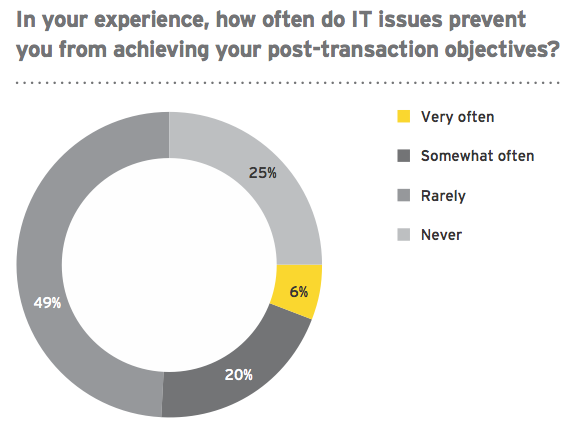
Giving IT a seat at the table
Discuss early how IT aligns to transaction strategy
One of the most common mistakes encountered in an M&A transaction is not involving IT. Only 50% of respondents said they typically involve IT in the transaction process compared to almost 80% for finance.
More specifically, the mistakes are not involving IT early enough in the transaction process or elevating IT to the right level within the organization. IT may be brought in late in the process to assess risks, but with no understanding of the synergy case or what cost savings the deal should deliver. “IT teams will focus on areas such as WAN connections or disaster recovery, but without asking key questions such as is the company growing into emerging markets? Is it looking for scalability? Is it enhancing its ability to share products?” says Tony Qui, Partner, Ernst & Young LLP. These questions need to be addressed with the right internal stakeholders — senior management including members of the C-suite. IT, alongside all other work streams, needs to understand the target company, the transaction rationale, the desired synergies and the key challenges as the acquirer understands them.
Yet less than half of the overall respondents say they are fully informed about IT-related decisions being made as part of the transaction.
To achieve better results with a transaction, one option would be to elevate the CIO to the senior decision-making level. Their strategic input should be shared early on and throughout the M&A process to assess risks and synergies and begin focusing on the difficult areas of integration. Additionally, there may be scope to broaden the career paths of CIOs to help diversify their experience and understanding of other business functions and the role IT needs to play in strategic transactions.
In retrospect, many respondents state that involving IT managers from the start is one of the best ways to ensure that time and cost estimates are realistic, and leaving them out almost certainly exposes a deal to losses. Looking back on his company’s most recent acquisition, the CFO of a consumer business based in Germany feels that inaccurate estimates were formed under tight time frames and without the right people. “Typically, the finance and legal managers are involved in the transaction process, and they set out firm targets that the IT integration team has to meet,” he says. “In my experience, the IT team finds that the integration costs exceed the estimates. There should be more time given to the IT team to understand the wider process and to identify potential road blocks.”
One CIO explains that higher-than-expected costs were only part of the problem. “After our most recent deal, our offices were tasked with developing and implementing the new IT framework after the sale process had started. This should be done simultaneously. Everything should work on day one.”
Involving IT managers at the early stages will allow for more accurate targets and could even speed up the process of realizing synergies. The CDO of an insurance company based in Finland says that in his company’s most recent acquisition, the IT team was involved in the transaction process and, as a result, was able to prevent value erosion early on. “We were able to identify issues with certain SAP and ERP projects, so we knew in advance where there would be delays. We put in a margin to allow for this in our time and cost estimates.”
“There should be more time given to the IT team to understand the wider process and to identify potential road blocks.” – CFO, consumer business
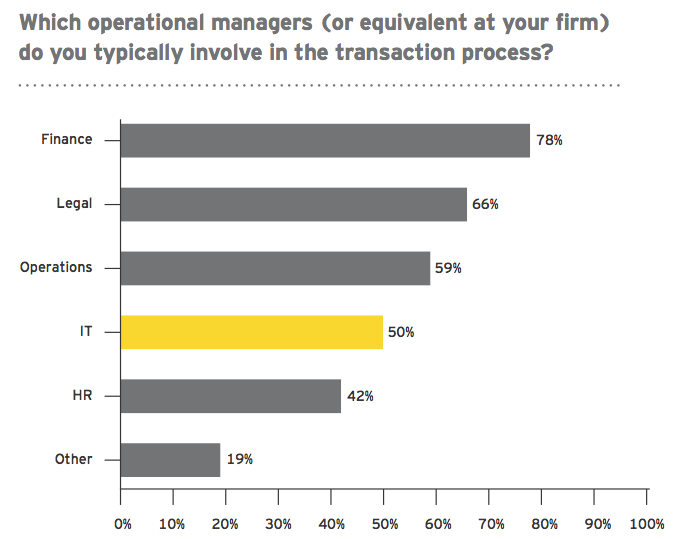
Critical pre‐deal IT steps
• Know your systems. As the Vendor, you need to have up-to- date information on all your IT assets, costs and initiatives to pre-empt IT being used as leverage in negotiations during pre-deal. Acquirers can only assess IT-related costs if they conduct a thorough due diligence on a vendor’s IT environment and organization. In the absence of data, the acquirer will make the assumptions on IT costs which may impact the purchase price. Therefore providing the right level of data will prevent this from happening.
• Involve IT early on. Unless the IT team is involved in the entire M&A process, synergy cases will depend on unrealistic benchmark figures, and it will be difficult to assess how IT can enable business synergies. IT staff should be made fully aware of what the deal is aiming to achieve and how they can aid in that goal. If a carve-out or integration is involved, bringing all workstreams together — finance, HR, IT, operations, sales — helps drive out interdependencies between workstreams and decisions that affect multiple business functions.
• Communicate deal objectives and synergy case. IT teams should not work in a vacuum. They need to understand the strategic rationale for the transaction to know where to focus diligence, e.g., synergies, operational efficiencies, growing market share.
• Plan for final goals. Management and IT need to create a template for the ideal system to fulfil the merged companies’ needs, and aim for that — it will focus on potential savings without affecting the end game of the merger plans.
• Plan for day one with a view to day one‐hundred. Ensure that there is a solid foundation for the company to operate under from day one of new ownership. In some cases, due to immediate cost-cutting programs, important IT staff have been laid off during the first week of the transaction, resulting in a lack of key know-how around important systems.
• Create a migration strategy. Legacy systems are one of the hardest aspects to confront after a merger. M&A directors should ensure that the people who understand legacy systems will be on board post-deal. Replacing knowledge of these systems can be expensive or even impossible.
• Transitional Service Agreements (TSA). Continuity of business is key and therefore identifying IT services, the costs and levels of support needed post-deal is essential for planning and negotiating TSAs with vendors.
Bandwidth needed
Don’t underestimate the skill set and time needed to make IT work
CIOs play a critical role is driving performance and change across a business. The skill set needed to deal with the myriad of risks and challenges posed by IT are very specific and deep.
Within the transactions arena, IT skill sets are extended to focus on supporting the overall business case for a deal, helping to capture synergies, reducing the risk delays and identifying IT capabilities to deliver and sustain growth.
The survey revealed that only 20% of respondents recognized IT as one of the most challenging areas to deal with post-transaction. However, as we have highlighted earlier, many of the problems encountered in other departments — such as knowledge sharing deficiencies or incompatible systems — also stem directly from IT problems.
Looking at pre-deal requirements and benefits, IT transaction skills help to form an objective view on the effectiveness of a target’s IT landscape in a very short time and potentially with very little information. It helps to uncover which aspects of IT diligence need to feed directly to the valuation of the target e.g., standalone cost dis-synergies, capex forecasts and inappropriate IT operating models. Ultimately, when assessing the required skill set and time, it comes down to being able to ask the same question multiple ways to get to the answers and uncover issues that aren’t necessarily obvious, easily uncovered or even being revealed.
“Post-transaction, we were focused on driving sales growth — but what we did not realize was that the engineering of our IT system, or rather the over-engineering of our IT system, was incurring a lot of costs.” – Partner, UK based PE company
External expertise
Many respondents we spoke to — 53% of corporate and 60% of PE respondents — say they are likely to enlist third-party support post-transaction. The help required post-deal ranges from the strategic — one corporate respondent refers to “formulating a hundred-day plan” while another refers to “readiness for day one” — to project-specific, troubleshooting tasks, often centered on IT.
A PE-operating partner based in the UK explains that third-party advisors came on board post-transaction to identify potential sources of value erosion, and found that IT issues were draining money from the business: “Post-transaction, we were focused on driving sales growth — but what we did not realize was that the engineering of our IT system, or rather the over-engineering of our IT system, was incurring a lot of costs.”
Many of these issues can be preemptively addressed if IT is involved at the pre-deal phases, but it is important to understand the unique skills required for this job. Corporate IT teams have functional and technical skill sets rather than transaction experience and typically are not able to allocate resources for due diligence and transition programs on a full-time basis.
External parties can be brought on board early in the process to provide support, guidance and leadership from pre-to-post deal where internal knowledge may be lacking or has been directed to other parts of the deal.
Third-parties can fill in gaps in internal IT team skill sets, including:
- Ability to engage with the vendor and ask the right questions
- Ability to form an objective view on the target’s IT infrastructure, often under tight time constraints and with limited information
- Knowledge of how IT due diligence feeds into the target’s valuation, meaning a solid grasp of standalone cost dis-synergies, capex forecasts and inappropriate IT operating models
“IT always features as a significant part of the deal process. One of the biggest problems is that people who are used to a certain IT system will be reluctant to switch to a new one. This can cause major delays in realizing operational synergies, because it takes time to migrate to the new system.” – CFO, leading European energy provider
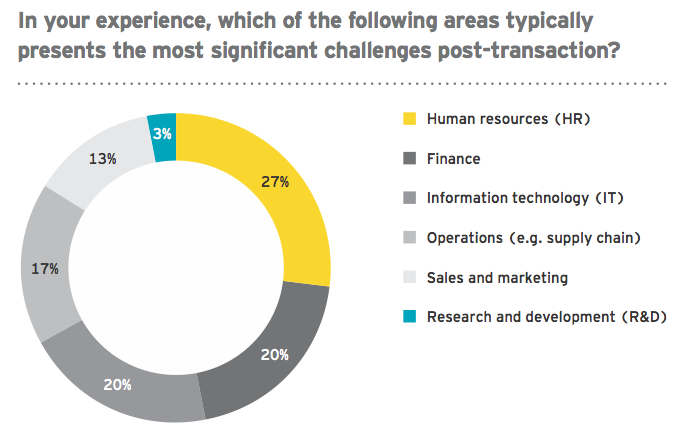
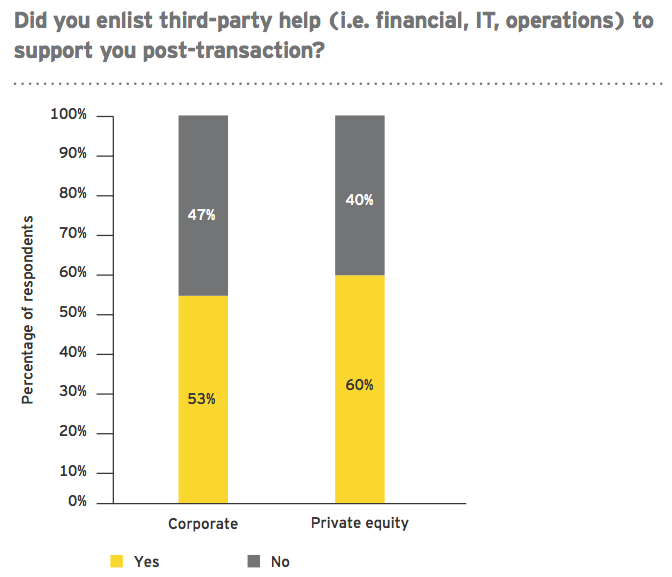
Conclusion
IT is critical in laying the groundwork for companies. The strategic rationale behind every deal is unique — these could be cost synergies; expanding into new markets; or increasing product offering — but all will inevitably be underpinned by IT.
When a deal closes, its original prospects could be dramatically altered due to IT. The company may find it cannot expand into new markets; or fields complaints from customers. If IT is not taken into account, there will be a direct impact on the value of the deal — the synergies that have been publicly announced will not be reached in the set time frame, share price will be negatively impacted and the deal will exceed costs and budgets.
IT plays a critical role in sharing product sets, product ranges, entering new markets and managing information. It also affects all other departments. If a corporation doubles in size, it needs to know exactly where all the information — accounting, financial and operational — gets trapped.
“Integrating systems can be an especially difficult task, and it is very important for processes to work. Working as a new company, everything is different, including customer care, and if you have a combined market approach, such processes have to be aligned on day one.” – COO, leading European IT services provider
Viewpoint: Interview with Dan Olley, CIO, Reed Business
How do you position the IT function within your business?
We position the “IT” function within Reed as a broader technology function, primarily because 60% to 70% of what we do is around online product development rather than the more traditional aspects of an IT department. This means we tend to be involved a lot more at the front of the business, rather than being seen as just a support function. From a transaction perspective, as we increasingly becoming a technology based business, the transactions we are looking at tend to have a very large technical product aspect to them. This makes it vital that technology is involved from the outset of the transaction.
What role should IT play in the transaction process — and when should they get involved?
Technology needs to be viewed as a strategic enabler in a business rather than a backroom afterthought, whether you’re in due diligence, or just in your normal day-to-day operations. At Reed, technology is heavily integrated into the due diligence process.
As a technology leadership team we have clear visibility of the company’s acquisition pipeline and appoint someone to act as the technology sponsor on each acquisition and divestment from its inception.
“If I look across most of our recent transactions, a large proportion, if not the largest proportion, of cost synergies come from technology or technology-enabled changes.”
How does IT impact transaction value?
Any transaction has to be based on a commercial rationale. In our case this typically has a strong technology component from deriving cost synergies in our, or the targets, infrastructure to supporting revenue synergies through product integration. The important thing is for technology teams to think commercially. Technology teams need to communicate in commercial terms during due diligence, and articulate synergies and risks in terms of their overall commercial impact on a transaction. Too often during due diligence, IT teams appear to be trying to scare everyone with risks they’ve identified rather than outlining the issue and then articulating a commercial quantification of the impact or resolution.
The other key impact is on the integration or separation timeline. Unfortunately by its nature technology is typically on the critical path of most post completion activities. It’s important that you build a clear time line from day one to fully achieving the synergy case. Nine times out of 10, it’s the technology dependencies that present a lag to that final goal and you need to look at these and understand the commercial impact of accepting that timeline versus the cost of acceleration. If I look across most of our recent transactions, a large proportion, if not the largest proportion, of cost synergies came from technology or technology-enabled changes.
How can IT teams achieve this level of involvement?
Reed’s CEO is passionate that technology is involved from day one, because we have seen how tricky transactions can get when we’re not. However, this position has to be earned by demonstrating that you are adding value to the valuation process through the due diligence and then delivering on the committed integration plans and synergy case.
“Our CEO is absolutely passionate that technology is involved from day one, because we have seen how tricky transactions can get when we’re not.”
How can IT teams develop this commercial mindset?
Technology teams tend to be pretty smart people, so just explain to them that the need to contribute to the overall valuation, they’re not there to try and prove why they’re technically better than the target or why a deal can’t be done because of some risk or other. As long as the teams you assign understand technology is one aspect of a business, and a business exists to make commercial returns, it tends to work. We clearly tell all our people there is no such thing as a technical decision: even down to the smallest one — such as desktop infrastructure, we make sure people can give a commercial rationale for their argument and think in commercial terms. The key is articulating in monetary terms how IT can enhance or reduce the case for a deal.
How do IT challenges vary from one transaction to another?
To be honest they really don’t. The aspects of which areas of technology you need to look at can vary depending on the target end state operating model, but the key principles remain. What is perhaps more important is what level of transactions do you do as an organization and therefore how much experience do you have in the organization and when do you seek help.
What drove your decision to seek outside help for the IT due diligence process?
Although we are a portfolio company, and transaction activity is not unusual, by its nature it is not constant. Typically, these [due diligence] activities are on a very constrained time period, on very short notice, and we don’t normally build teams to have a contingency in the workforce to address this. You’ve got to be able to flex up quickly, with people who can hit the ground running from day one. It’s also not something the internal teams work on day in and day out and therefore, both from a resourcing perspective and an experience perspective having assistance from a team of specialists is absolutely vital.
So many deals fail to deliver the expected results, despite clearly outlined synergies and sharp due diligence processes. Why do you think this is?
If you work out a synergy case based on high-level metrics and benchmarks, and a couple of financial spreadsheets, you will always get it wrong. You need to get under the covers, do the work, understand where the real detailed synergies are, and build your case back up. It’s the only way you can be sure — and that’s what due diligence is.
Which industries will require a greater focus on IT issues going forward?
I think the bigger question is to what extent is technology becoming an absolutely critical factor for businesses? If you’re not online and not embracing technology, you probably won’t be here in a few years. We’re already seeing this in the media industry, and in the travel industry. With businesses becoming more dependent on technology, it is very unwise to view due diligence in a generic way. If due diligence is about taking risk out of a deal, then why would you gamble about such an important factor?
The bigger question is, to what extent is technology becoming an absolutely critical factor for businesses? If you’re not online, and not embracing technology, you probably won’t be here in a few years.
Viewpoint: Financial services
The financial services industry — particularly amid the ongoing economic turmoil — is ripe for consolidation. The fundamental role played by IT in the sector means acquirers face specific complications.
With financial houses under pressure to raise capital and in some cases repay government funding, deals are more likely to be rushed through tight time frames. Having robust standards in place, especially with mainstream software packages, can ease the process, but a rushed job is inevitably a leap of faith.
“If you look at the banking industry over the past couple of years, we’ve seen a lot of transactions taking place in response to regulatory pressure and the impact of the financial crisis. Many banks have been sold or dissolved into other entities, rationalized, or sold to competitors,” says Christopher Schmitz, Partner, Ernst & Young GmbH.
Against this backdrop, there are key considerations that affect IT’s role in an organization and need to be understood by any third-party consultants brought on board. These include:
• Security issues: higher in financial services than in other sectors. Both in-house and customer-facing services are critical and subject to numerous governance standards, such as the Payment Card Industry Data Security Standard. If merged companies aren’t properly aligned, they risk security breaches, which could result in costs and scrutiny from data protection regulators.
“IT is a key enabler in financial services. The dynamic regulatory environment of the past years has imposed increasing requirements on IT. In M&A situations, fast and clean IT carve outs and integrations are prerequisite to implement divestiture, restructuring or acquisitions to free capital or leverage synergies.“ – Christopher Schmitz, Partner, Ernst & Young GmbH
• Data: higher throughput and reliance than in other sectors, plus there is the issue of IT infrastructure supporting real-time data used for decision-making, data delivery has to be reliable and it has to be timely and accurate.
• Bandwidth and latency: for high-frequency trading firms, speed of data both in volume and delivery is key. Traders need to be able to trade at the optimum moment on markets where prices are constantly changing. Cable companies claim a few milliseconds can make a multi-million dollar difference to a trader’s account each month if they can beat rivals to the deal. This lifeline needs to be managed, but could be done more cost effectively if both companies were to use the same provider.
• Regulatory and compliance issues: financial services companies face rigorous regulatory scrutiny, which is getting tighter with the introduction of Basel III and Solvency II. However, technology can also make reporting more accurate and timely — if the right tools are in place and properly audited.
Methodology
In July and August 2011, Mergermarket conducted a survey on behalf of Ernst & Young EMEIA with chief information officers, C-suite and board level directors, as well as PE investors from across Europe. The aim was to canvass their opinions on the role of IT in the M&A transaction process.
All survey participants were involved in an M&A transaction within the prior year. They were asked a variety of questions about their views and experiences in relation to IT planning, due diligence and post-merger integration and carve-outs.
A total of 220 telephone-based interviews were carried out and the results presented anonymously and in aggregate.
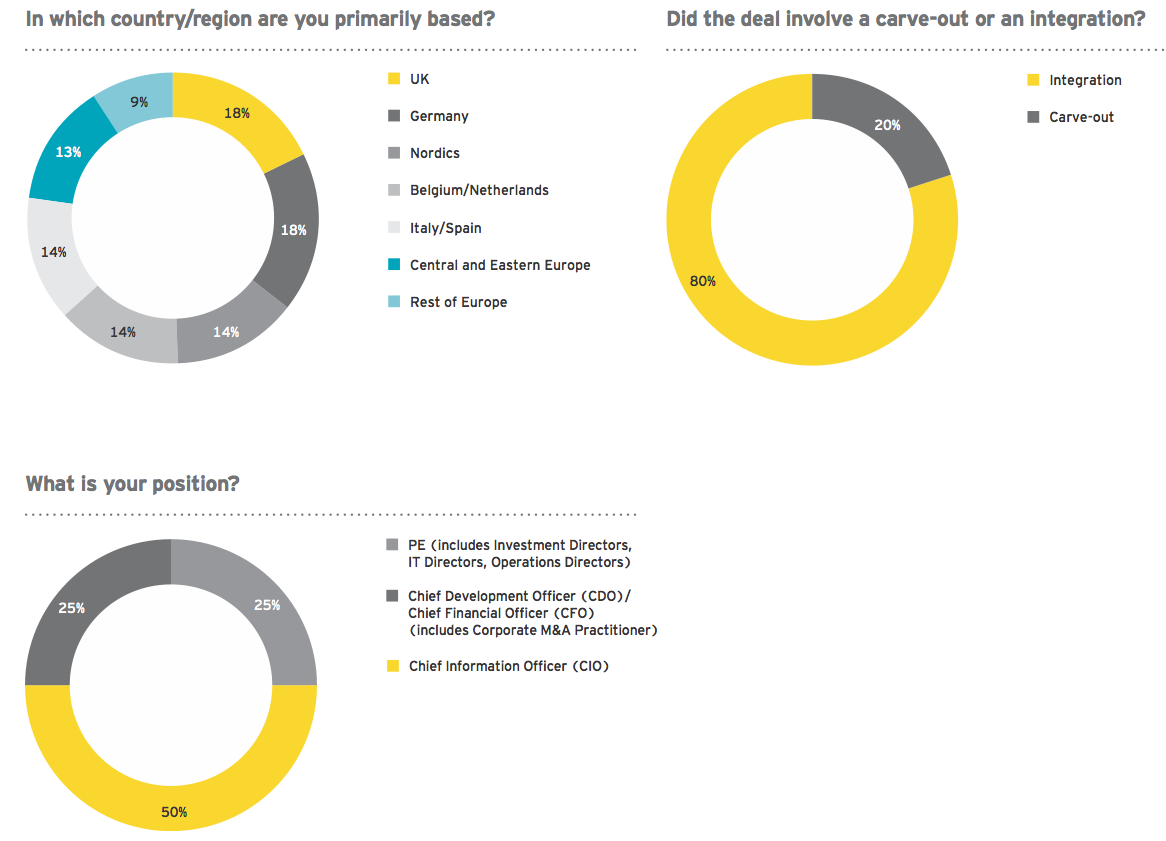
TAGS:


Stay up to date with M&A news!
Subscribe to our newsletter


